Reflection on rehousing CAM’s Footwear collection
Some of us are just crazy about shoes — new shoes, old shoes, those in good order, those worn down through use and time. Quite aside from thinking of footwear as fashion items, we can see shoes as something like a short story which a skilled reader can interpret. In this delightful reflection, CAM honorary Conservator, Deborah Peart discusses some treasures in the collection: an astonishing shell work by First Nations artists from La Peruse in NSW as well as other small treasures in the local history collection. As part of CAM’s Digitisation Roadshow (supported by Creative Victoria), Peart introduces some of the issues around the care and housing of our footwear collection. Peart also invites members of the community to contact us if they have information to share about the items she is rehousing.
Reflections on rehousing CAM’s Footwear collection
Rehousing CAM’s varied footwear collection provides the opportunity to explore community connections, skilled craftmanship and the fascinating features of worn footwear. The collection ranges from baby shoes to wedding shoes and boots and ornamental shoes from the late 19th century to more contemporary items. The collection is predominately made from leather.
The term ‘leather’ refers to skin products that have been fully tanned. This process chemically alters skin, producing a product made of collagen, moisture, oils and fats with improved durability and reduced potential for rot. Nevertheless, leather goods in collections are susceptible to deterioration and need to be managed. Leather, being vulnerable to temperature and relative humidity extremes, requires storage that buffers the item from the external environment. Shoes are protected in acid free tissue or calico in well ventilated archival boxes or shelving to reduce dust, desiccation, light damage and harm from mould and insect attack.
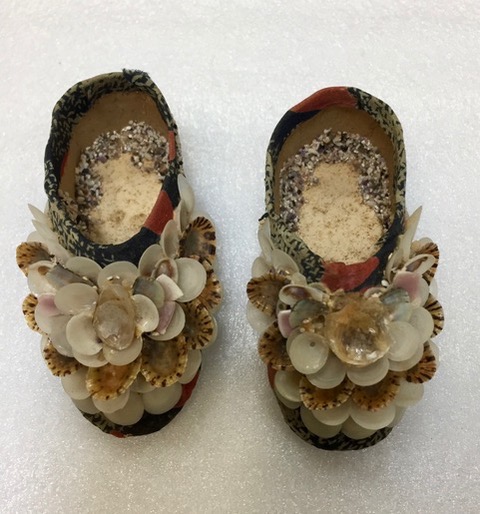
The miniature shellwork baby shoes currently exhibited in the Unquiet Landscape exhibition however, are constructed from an assembled cardboard substrate joined together with adhesive and fabric. Constructed by Aboriginal women from the La Perouse community NSW for the tourist market, they reflect the Victorian era taste for shell craft that was popular from the second half of the 19th century.
Their striking feature is the delicate arrangement of mollusc shells adhered to the front of each shoe while the patterned fabric and coloured sand displays handiwork and decorative use of readily accessible materials. In preparation for the exhibition the shoes were treated with a brush clean, shell repair and reattachment of detached shells with conservation grade acrylic adhesive. The shell shoes present unique conservation concerns for the longer term due to the combination of materials and delicate construction. Shells are susceptible to chemical and physical breakdown in the presence of acidic vapours. Due to their vulnerability to both physical and environmental damage the shoes will be housed in a customised archival box lined with Ethafoam® and Tyvek®.
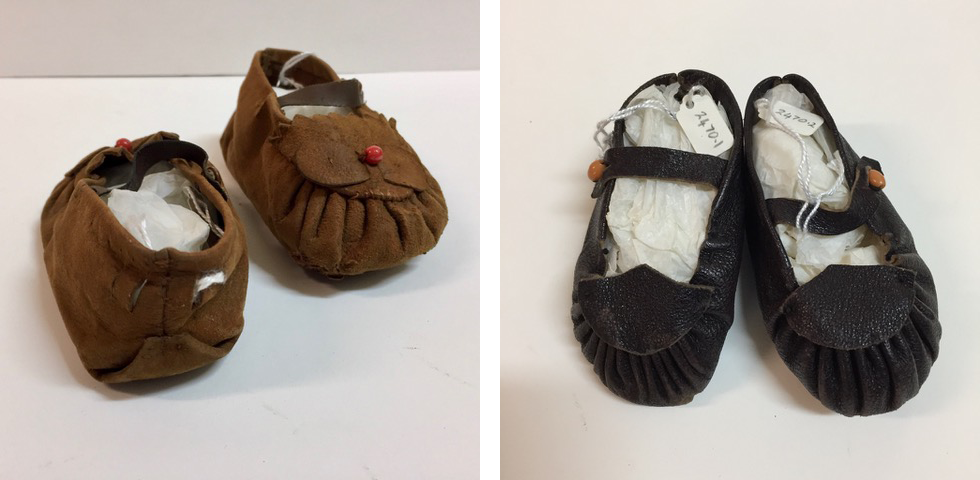
Interestingly, two small pairs of baby shoes in the collection were worn by the Gallery’s first female Director (1969-1975), Beth Sinclair. The moccasin style construction with visible hand stitching in tan suede, black leather and glass beads, were made by her father the water colourist RW Sturgess. These were her first baby shoes and show the impressions of her tiny feet on the soles as well as a hand stitched repair.
The museum holds a delightful pair of very small child’s shoes worn by Ms Nan Cherry the niece of Ms Anna Brotherton, a founder of Castlemaine Gallery and Museum. The shoes are fully lined leather with a solid leather sole and stacked heel with metal eyelets. Although displaying signs of wear, the shoes are in very good condition.
In contrast to leather items used in daily life, lubricating of leather in museum collections may be problematic. Excess lubrication can alter the natural acidity and moisture / fat equilibrium of leather resulting in hardening and mould formation. Fats and lubricants or moisture may cause corrosion of metal components such as eyelets and buckles A turquoise-blue waxy corrosion product is often found on copper alloy rivets. . The corrosion product in turn can degrade the surrounding leather. Treatments and barrier layers may be employed to prevent contamination of the leather.
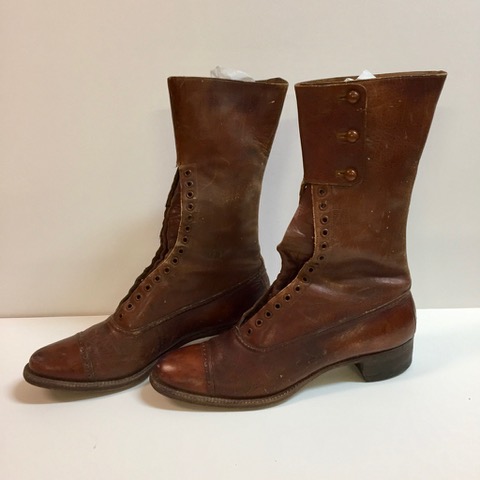
The above lace up boots with buttoning flap at the calf and hard toe cap were purchased from Buckley & Nunn Ltd Melbourne. Identified possibly as ‘Russian calf lace boots 1909’, 1 the boots feature decorative seams, a lighter shade leather lining and an unlined leather tongue. Scuff marks and abrasion areas are evident – the role of conservation is to stabilise materials, prevent further damage and to retain those aspects of an object that provide meaning and value rather than to make the object appear new.
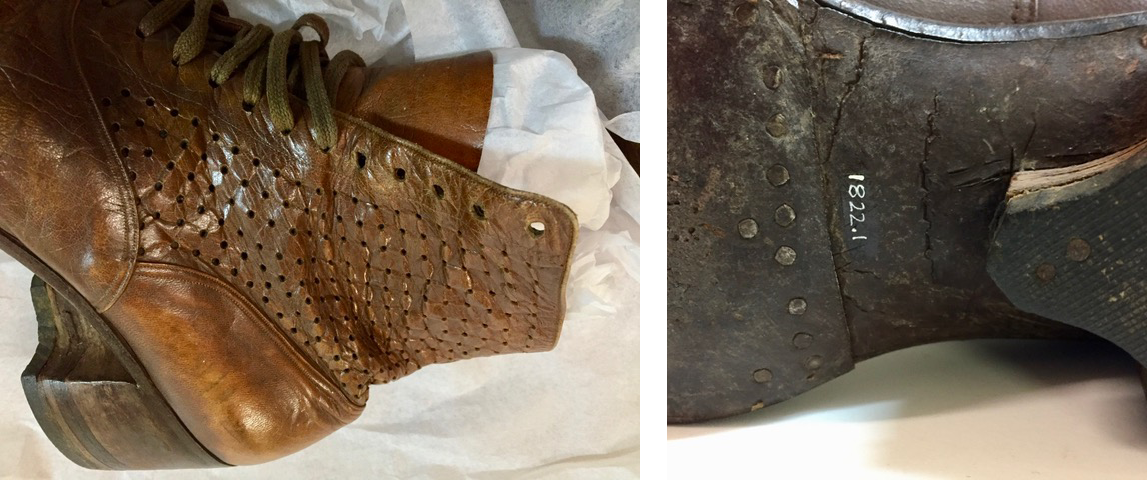
A reader of CAM Reflections may be able to shed light on a fascinating pair of lace-up heavy woman’s leather boots with unknown early provenance, found at a property in Fletcher Street Castlemaine. Featuring a heel with a bridged instep, full leather tongue and decorative punch hole work on the shaft. The chunky sole and stacked leather heel show evidence of regular wear and repairs.
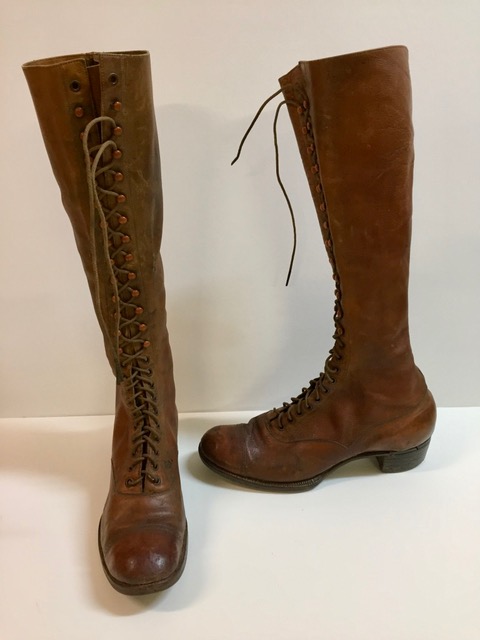
To maintain a three-dimensional shape, prevent folds, creases and cracks, footwear requires internal and external support. The woman’s knee-high calf leather riding boots above with eyelets and hooks require support padding to maintain their elegant shape. Well-designed housing for footwear reduces the need to handle individual pieces, minimising the opportunity for damage.2 In comparison to modern synthetic footwear subject to unknown inherent vice, leather shoes have displayed longevity in well managed environments.
The footwear collection has revealed fine workmanship, artistry and resourcefulness of the makers and repairers. We glean something of the lives of the wearers.
Do your shoes have a story to tell?
Scandrett, E 1978, Breeches and bustles: An illustrated history of clothes worn in Australia 1788-1914, Pioneer Design, Lilydale.
Boston Museum of Fine Art, Conservation in Action: Preserving Shoes and Footwear at the MFA Boston.
Deborah Peart
July 2020